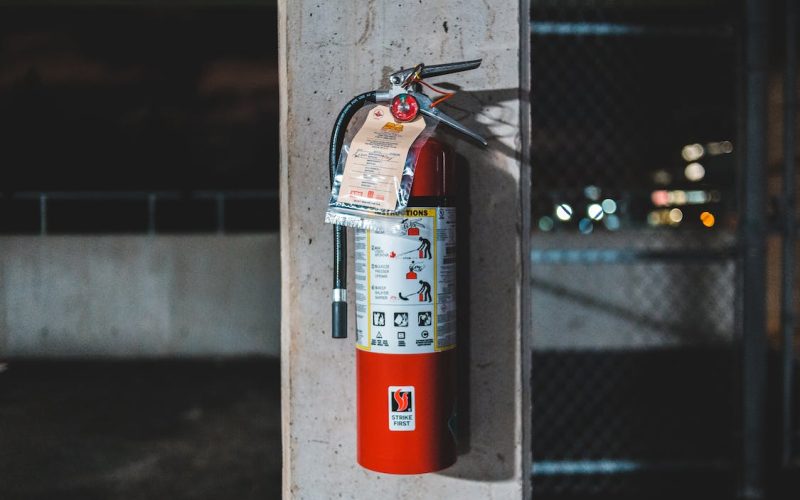Not all Kitchen fire extinguishers are suitable for homes; we collect some of the factors that will help us to know which one best suits our space and needs Although a priori it may seem like an unnecessary bulky device, the truth is that most fire experts recommend having a fire extinguisher on hand inside the home, or one near the landing and the community stairs. The latter is required under current legislation.
The reason to consider having a household fire extinguisher is that you never know when a spark, a lit cigarette butt, or the contents of a pan with hot oil could connect with some textile or flammable material and cause a fire.
In this sense, in order to extinguish a fire it is necessary to eliminate the component that originates it. From this data, we can distinguish three types of fire extinguishers by their way of acting:
- Those that impinge on oxygen extinguish it through suffocation.
- Those that affect the combustion energy, by cooling.
- Those that inhibit the flame, through a break in the chain reaction.
But not all fire extinguishers work for our home. To choose them properly, six questions that we should ask ourselves:
What kind of fire is it that you want to put out?
The types of extinguishers vary according to the type of fire that is intended to be put out. The most common on the market, “are class A, specifically for extinguishing fires in solid materials such as wood, cardboard, plastic, etc., and the most used in establishments, shops, restaurants, and homes”.
There are also those of class B, used to extinguish fires produced by liquid fuels such as gasoline or paint, among others. Those of class C put out fires produced by flammable gases such as natural gas or butane, while those of class D do so with fires where light metals such as magnesium or aluminum are present.
Finally, those of class F “is used to put out fires derived from the use of cooking ingredients (vegetable or animal oils and fats) in kitchen appliances.
What types of fire extinguishers are on the market?
- ABC chemical powder extinguishers: they put out the types of fire that their name indicates and they do so by suffocating oxygen, with a fireproof powder mixed with nitrogen gas. “It is not toxic nor does it conduct electricity, it is resistant and stable in extreme temperatures”.
- CO2 extinguishers: suitable for types of B and C fires, they are the ones indicated for electrical equipment, elevator rooms, etc. and we must leave the place when the fire has been extinguished. They extinguish by cooling, that is, by attacking the energy or heat of combustion, and they achieve it by propelling compressed CO2. They do not dirty, they have a fast penetration and distribution of the gas and they do not conduct electricity.
- F foam extinguishers: they work by attacking flammable surfaces or materials with water and additives. “They are ecological, they do not cause suffocation, they do not make it difficult to see or breathe. They are suitable for class A, B, and F fires, but not for class C and D. They are also common in restaurants, hotels, homes, and all types of kitchens”.
Which is the most recommended for a home?
The most appropriate fire extinguishers for the home are those with 3 kg of powder, although it would also be beneficial to have one with 6 liters of water with foam concentrate.
He agrees with Duque, who affirms that “to cover all the risks in a home, it may be interesting to have an ABC chemical powder extinguisher and another F foam extinguisher “.
This is because ABC chemical powder extinguishers are suitable for any room, so they are common in areas such as the kitchen or in the event of fires involving electrical appliances.
However, the F foam “only works for fires derived from the use of cooking ingredients in kitchen appliances, but it is not suitable for fires produced by flammable gases”.
Although ABC extinguishers will render all electrical appliance wires and circuits useless, they are a better alternative to water, which can also render them useless, or even use electricity transmission as a conductor to spread the fire.
Regarding CO2 extinguishers, the truth is that they are an option that respects electrical circuits and can be used on liquid fires, but requires prior knowledge of the device since CO2 at low temperatures can cause severe frostbite. In addition, in closed spaces, excess CO2 can be toxic.
Where should I place it?
“Fire extinguishers must always be visible and as close as possible to the exit from the house since we will never go through a room to get the extinguisher in case there is a fire”.
We must follow the instructions of the anchoring system that will come with the extinguisher and we must not forget to place the signaling sign next to it so that anyone can know the instructions for use. “If the house is on one floor, in principle one would be enough, if not, it is recommended that there be one per floor.”
As for the placement area, it is recommended that it always be close to dangerous areas such as the kitchen, or near the exit from the house, to always have easy access. It should never be left in areas where the fire prevents us from reaching it, such as inside the kitchen, at the end of the living room next to the windows, etc.
It is always better, therefore, to place it in the areas of the access door to sensitive points, but always outside these rooms.
How should I handle it?
Although all extinguishers by law must include the explanation corresponding to the way of use, when using them, “it is important to hold it vertically, since an incorrect hold does not allow the extinguishing agent to be poured at the base of the fire”.
First of all, we must pull the ring of the pin to remove the seal, check that the fastening is correct and take the hose by the tip of the nozzle if it has one.
Afterward, the handle is pressed and the jet is directed at the base of the fire, it is advisable to press and release making zigzag movements at the base of the flame.
When should I change it?
The useful life of a fire extinguisher is 20 years from its date of manufacture since the materials can be weakened. In addition, as established by the Fire Protection Regulations, “it is necessary to carry out a pressure test every five years and a review at least once a year to ensure that the equipment is safe”.







